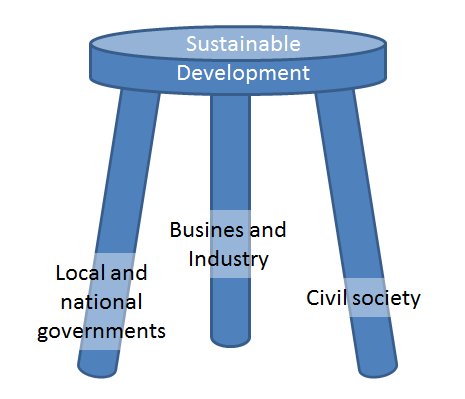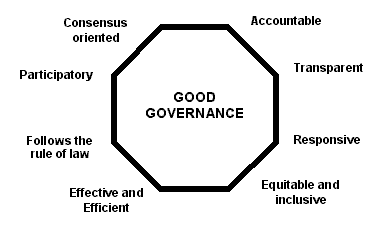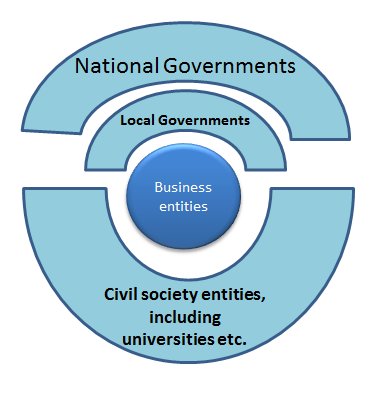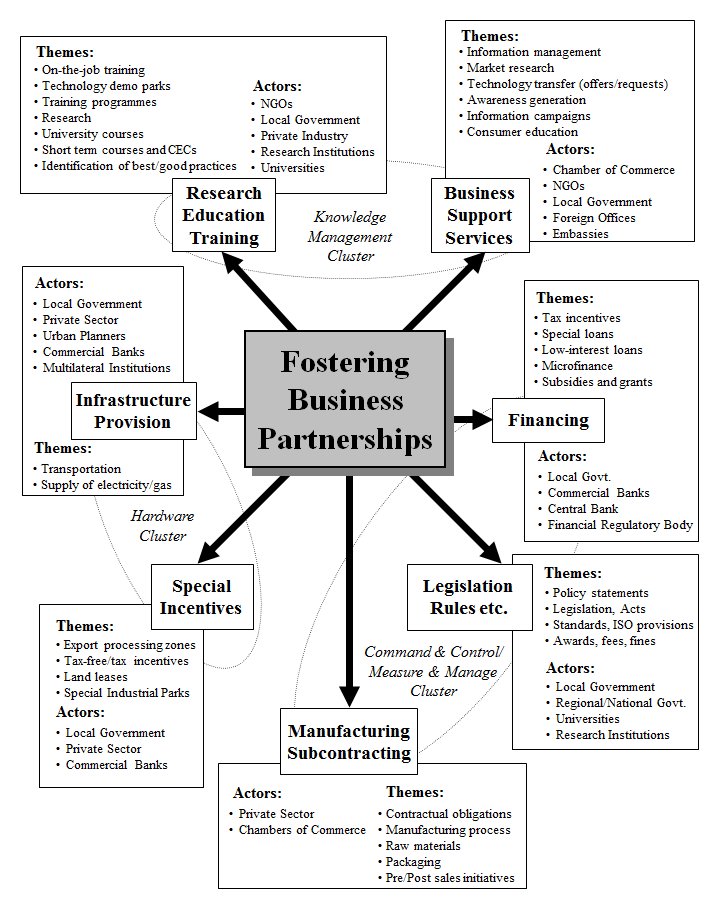Fostering Business Partnerships for Environmental Sustainability |
| Hari Srinivas | |
| Policy Analysis Series E-076. June 2015 (Updated April 2022). |
|
Abstract This document explores the critical role of local governments in fostering partnerships with the business sector to advance environmental sustainability. It emphasizes how such partnerships offer an alternative to privatization by leveraging the strengths of both sectors - entrepreneurial innovation and public accountability - to address urban environmental challenges. Through a review of good practices, case studies, and interviews, the document proposes a working framework comprising three policy clusters: regulatory mechanisms, infrastructure and incentives, and knowledge management. It underscores the interconnectedness of sustainable urban environments and strong local governance and highlights the need for inclusive, participatory processes in developing long-term strategies for local environmental action.
Keywords |
1. Introduction
What exactly are business partnerships? For the local or city government, it is an opportunity to provide an appropriate and enabling environment where economic activities can take place, and participation of the private sector in public projects is facilitated. For the private sector, it is increased business opportunities for providing better products, better services, and developing sustainable technologies - which wmay lead to sustainable development in the long run.In the context of this document, a business partnership can be seen as a forum for dialogue between the local business community and local governments. The objectives of these partnerships are to enhance the flow of information and to promote business opportunities and joint activities between local governments and the private sector.
Business partnerships are alternatives to full privatization in which local governments and private sector companies assume initiative and co-responsibility in focussing on the sustainability and environmental effect of private firms. Through effective and equal partnerships, the advantages of the private sector - dynamism, access to finance, knowledge of technologies, managerial efficiency, entrepreneurial spirit - are combined with the social responsibility, environmental awareness, local knowledge and job generation concerns of local governments.
Partnerships are a central feature in any project, from development of the idea to the actual implementation. As a result, business partnerships ensure the build-up of a body of expertise on the issues, which in turn allow functions to be carried out efficiently, reliably, and profitably. There are certain circumstances in which it is advantageous to have local governments, communities and the private sector play active roles, thus bringing to bear the strengths of each sector in resolving urban and larger environmental problems.
The above discussion is in line with current trends to place emphasis on the civil society at large, with local governments, businesses, and the community forming its three 'legs' that support it. Active involvement and participation of all the three components are essential for the success of any local/urban initiative.

Figure 1: The Three Legs of sustainable actors
While local governments have used environmental management systems as a part of the ISO 14001 [ ★ ] and other tools to promote environmental sustainability in businesses and other entitites. Businesses have similarly used management conceptss such as corporate social responsiblity (CSR) and a number of other tools, including ISO 14001 itself, to be more sustainable.
Successful business partnerships have been built on existing schemes of cooperation, without creating 'new bureaucracies' and have helped create clearer lines of communication to prevent duplication of efforts and meet new locally defined needs. Existing groups such as chambers of commerce, guilds, business associations have played an important role in sustaining partnerships.
A review of case studies and good practices was done, along with informal interviews, with local government officials, during a meeting in Esfahan, Iran, on the theme of urban governance. This resulted in the development of a macro policy framewrok to foster business partnerships. The policies are clustered around three clusters of issues: (1) legislation, rules, manufacturing, subcontracting etc. (2) infrastructure provision and special incentives; and (3) research, education and training, and business support services.
The framework looks at the intersection of two critical themes that have emerged recently - growing concern for a sustainable local environment, and focus on stronger local governance, both of which are intrinsically linked together in urban areas. Recognising this, the document looks at these two issues specifically from the view point of partnerships between local businesses and the local government aiming towards sustainability of the local environment.
2. Sustainable Local Environments
'Environment' means different things to different people. For some, it means separating garbage into burnable and non-burnable items. To others it means saving on electricity or using less water. The term 'environment' may be associated with restoring the vitality of tropical rain forests, maintaining biodiversity and arresting desertification. Developing healthy, sustainable and safe communities becomes important to yet others. The environment also means agricultural and industrial production that is sound and 'green'. Some associate man-made chemical and nuclear hazards with concrete environmental policies. All of these views are right in their own way, and are united in its concern for the effects that the environment has on the day-to-day lives of current and future generations.The concerns and problems associated with the environment have placed such issues high on the agenda of bilateral and multilateral meetings. The 1992 Earth Summit held in Rio de Janeiro managed to highlight and channel global efforts in understanding and acting on environmental problems, making it a key issue to be tackled in trade and commerce, in economic and social development, and in science and technology. These messages were further enhanced and expanded in the two Earth Summits that followed, in 2002 at Jo'burg (Rio+10), and in 2012 again at Rio de Janerio (Rio+20). Other summits and congresses such as the Social Summit and the Beijing Conference on Women in 1995, the City Summit/Habitat II in 1996, not to mention innumerable regional, national and local meetings, all have had the larger global environment as a key common denominator in its action plans.
It is only in the last 50 years or so that a better understanding of the effects of changing environments and ecosystems have been developed. Interconnectedness of these factors has forced particular attention on human lifestyles and living conditions that has had a profound effect on its surroundings. Most, if not all, environmental problems that we currently face can be traced back to the legacy of lifestyles that we are inheriting and leading as human beings. Nowhere is this more true than in concentrations of urban lifestyles that are becoming a key choice for the majority of humanity.
- UN HABITAT
|
By the turn of this century, we will be witness to a ubiquitous scenario where more people will live in and around cities than in rural areas. Proximity to decision-makers and financial markets, large pools of skilled and unskilled workers, and other advantages have made such urban areas the engines of growth for the countries and regions where they are situated. For example, despite the environmental and social problems that it is facing, Bangkok's contribution to the national GDP has been estimated to be more than the combined output of all other cities in Thailand.
The result of this has been the explosive growth of urban areas, bringing with it a host of negative effects. Population concentration in increasingly smaller land masses has caused a drastic decline in the quality of living both in the residential and work fronts. Cities have, in effect, become a barometer of humankind's progress into the 21st century, whether this is an upward or downward trend. Such a scenario has had ripple effects on a variety of sectors such as education, health, labour/job markets, and economic activities [UNESCAP 2015].
The growth and effect of an urban area should be seen not only in terms of its immediate boundaries, but also in terms of the resources necessary to sustain its population. An illustrative example is that of the Greater London area. The land mass that generates the resources necessary to sustain the population of London, called the 'urban footprint,' is actually slightly less than the entire land area of UK! This illustrates the complex interrelationship and interdependence of urban areas and their surrounding hinterland [ ★ ].
According to the Earth Council's report, "Ecological Footprints of Nations" Japanese lifestyles generate a demand for 6.25 hectare per capita (for resources such as energy, arable land, pasture, forest, built-up area, etc.). But the supply has been only 1.88 hectare per capita. This leaves a 'ecological deficit' of 4.37 hectare per person that has to be met from outside the country. The conurban region of Tokyo had a 1995 population of 26.8 million. For Tokyo alone, this ecological deficit is equal to 116,242,000 hectare or 3.07 times the total land area of Japan. This becomes 9.2 times the land area of Japan if only habitable land is taken into account (excluding mountains, water bodies etc.)
The effects of urban activities have in many cases outweighed the relative advantages of agglomeration and centrality that they offered. Thus, along with the benefits of urbanization come environmental and social ills, including lack of access to drinking water and sanitation services, pollution and carbon emissions etc. A wide variety of urban problems can be observed, grouped under two broad contradictive classes, those associated with poverty and those associated with economic growth and affluence.
Urban areas present a series of trade-offs - for example, between greater convenience and higher costs, between proximity and congestion, between better communications and busier lives. Balancing and bringing together these different issues to aim at sustainable local environments remains a key challenge that has many regional and global repercussions.
3. Stronger Local Governance
Simply put, governance is the science of decision-making. The concept of governance refers to the complex set of values, norms, processes, and institutions by which society manages its development and resolves conflict, formally and informally. It involves the state, but also the civil society (economic and social actors, community-based institutions and unstructured groups, the media etc.) at the local, national, regional and global levels.

Figure 2: Characteristics of good governance (Source: UNDP)
Governance refers to the process whereby elements in society wield power and authority, and influence and enact policies and decisions concerning public life, and economic and social development. Governance is a notion that is broader than government, whose principal elements include the constitution, legislature, executive and judiciary. Governance involves interaction between these formal institutions and those of civil society. Governance has no automatic normative connotation. However, typical criteria for assessing governance in a particular context might include the degree of legitimacy, representativeness, interdependence, popular accountability, compliance, transparency and efficiency with which public affairs are conducted [UNDP 1999].
There is no alternative to working together and using collective power of disparate actors and objectives to create a better world. Governance is the sum of the many ways individuals and institutions, public and private, manage their common affairs. It is a continuing process through which conflicting or diverse interests may be accommodated and co-operative action can be taken. It includes formal institutions and regimes empowered to enforce compliance, as well as informal arrangements that people and institutions either have agreed to, or perceive to be in their interest.
Examples of governance at the local level include a neighbourhood co-operative formed to install and maintain a standing water pipe, a town council operating a waste recycling scheme, a multi-urban body developing an integrated transport plan together with user groups, a stock exchange regulating itself with national government oversight, and a regional initiative of state agencies, industrial groups, and residents to control deforestation. At the global level, governance has been viewed primarily as intergovernmental relationships, but it must now be understood as also involving non- governmental organizations (NGOs), citizens' movements, multinational corporations, and the global capital market. Interacting with these are global mass media of a dramatically enlarged influence.

Figure 3: Partnerships that Help Businesses to Contribute to Sustainable Development
Thus, a strong local governance system lies at the root of local urban development, working as a common dinominator for a variety of urban functions. It is important to understand the broad nature of the concept of governance, and the interconnectedness of the issues and actors involved.
4. Bringing the environment and governance to the local level
To have a lasting and effective impact on sustaining the global environment, action starts at 'home' - at the local level. The above discussion clearly points to the importance of merging good governance and localizing environmental action (this was indeed the goal with which the Local Agenda 21 initiative was launched at the 1992 Rio Summit)
There is a need to initiate a process that aims to involve local people and communities in the design of a way of life that can be sustained and thus protect the quality of life for future generations. This calls for integrating the social, environmental and economic aspects of development in order that all future development is 'sustainable'. It requires all of us to consider the effects - on the local economy, the local environment and the local community - of every policy, programme and project, and then to seek a solution that achieves a realistic balance.
This has to be done in a highly democratic, consensus-building and empowering process. It should seek to strengthen the role of all major groups in society, including children, youth and women - setting out to develop and build on partnerships between groups in the local community and to make linkages between parallel processes such as social needs and health for all policy work.
Bridging sustainable environment and good governance at the local level requires a refocusing on 'quality of life' - which is perhaps a more friendly term to describe its primary goal. It is a process that asks those in local government to work in partnership with the local businesses and the local community to develop a strategy that will work towards the goal of sustainable development in the twenty-first century and beyond.
There is a need therefore to highlight the role of local governments in fostering partnerships with businesses to achieve environmental sustainability. A working framework has been developed that positions the various actors, issues, and themes into three distinct clusters and interlinks them.
5. A Working Framework for Business Partnerships
Developing a working framework for business partnerships requires the promotion of greater cooperation and networking between Asian local governments and businesses. The objective is to (a) share and transfer success stories and good practices in developing partnerships for urban development, (b) utilize appropriate and sustainable technologies and practices, (c) foster research and development in business partnerships, and to identify information dissemination strategies.Partnerships do not simply happen. There is a clear need for a macro level framework to be developed, which will bring together disparate resources and stakeholders working towards sustainable urban areas.

The review done as a part of of the background research for this document resulted in the development of a macro policy framewrok to foster business partnerships. The policies are clustered around three themes (see Figure 4):
- Command and Control/Measure and Manage Cluster covering legislation, rules, manufacturing, subcontracting etc.
- 'Hardware' Cluster covering infrastructure provision and special incentives
- Knowledge Management Cluster covering research, education and training, and business support services.
It is important to understand the issues covered in the clusters, and the actors that will activate them. This is due to three reasons:
- in order to emphasize the importance of linkages and interrelationships between the various issues and actors;
- the need for a broad range of interventions and inputs that foster partnerships; and
- the criticality of a holistic view that needs to be taken in developing sustainable business partnerships.
5.1 Command and Control/Measure and Manage Cluster
There are a number of governance issues that affect the creation of partnerships for sustainability - related to "command and control" structures (particularly laws, rules and regulations) within local governments as well as more broader involvement to "measure and manage" change (for example through the ISO 14001 codes).This cluster covers three issues of legislation, rules etc.; financing; and manufacturing/ subcontracting.
- Legislation and rules need to be put in place to support and foster business partnerships - local government policies, acts and similar legal provisions should be provided for. A campaign to educate businesses in local/national environmental standards, ISO standards . Means to highlight good practices by a system of awards, fees, fines etc. can also be used. Besides local, regional and national governments' role in promulgating the legislation, universities and research institutions, chambers of commerce etc also have a role to play in generating greater awareness.
- Financing - respecting the 'bottom line' approach of businesses, it is necessary to have a supportive financial system that incorporates instruments such as tax incentives, special/targeted and low-interest loans, microfinance for SMEs, subsidies and grants for capital investment etc.
- Manufacturing and subcontracting - while it is difficult to play a direct role in influencing the manufacturing process of local industries and businesses, local governments do have a role to play in educating and campaigning both manufacturers and consumers in environmental issues throughout the lifecycle of a manufactured product. Besides voluntary initiatives of the industry or firm itself, chambers of commerce, industry associations, consumer groups, co-ops etc. have an important role to play in this process.
5.2 Hardware Cluster
Making sure that the necessary local services are in place (the urban hardware components) is key to locational and strategic decisions of businesses, and local governments play a very important role in influencing such decisions.The 'Hardware' cluster focuses on providing necessary and adequate network and social infrastructure facilities for the industry. It also includes making available special incentives.
- Infrastructure Provision - This involves the provision of various infrastructure facilities such as proper transportation (roads, public transport, etc.), electricity and water, gas, telecommunications etc. Many actors have a role to play here - besides local governments themselves, the private sector, urban planners, commercial banks, multilateral institutions have a stake in providing adequate urban infrastructure facilities
- Special Incentives - This involves the setting up of special facilities such as export processing zones, tax-free zones, special land leases, industrial parks etc. that also double as showcases for environmental friendly industries.
5.3 Knowledge Management Cluster
Providing the right information to the right catalyst in order to take action is critical, particularly in addressing problems, and the use of appropriate policies to bridge problems and solutions.The Knowledge Management cluster focuses on the 'software' part of the framework, by enabling research education and training, information dissemination, awareness building, and other business support services.
- Research, Education and Training - This issue cuts across a broad spectrum of actors and activities, and covers targeted on-the-job training, demonstration projects, vocational training, research and learning, good/best practices documentation etc. With education and awareness building being the key activity, a wide range of actors from NGOs and community groups, universities and research institutions, industry associations and chambers of commerce, have a role to play in facilitating greater participation for environmental action.
- Business Support Services - These services are targeted directly at businesses and industry, and provides key information, market research, new technology information, consumer information etc. in order for businesses to make an informed choice towards environmentally friendly manufacturing and business practices.
6.0 Conclusions
The process of promoting sustainability in private sector companies is complex, not in the least because a profit-oriented entity will find it difficult to justify the uptake of sustainable principles for the good of the broader society. Yet it is changing, and businesses are now seeing the relative value in engaging with the broader community, as seen by the popularity of concepts and initiatives such as corporate social responsibility (CSR) and global reporting initiative (GRI).
A key driver that kick-starts this process is peer-to-peer learning, where businesses learn from the experience of other businesses. Such partnerships between businesses go a long way to making the path to sustainability smoother.
Fostering business partnerships that help in peer-to-peer learning is therefore critical to ensure long-term and sustained action. Such partnerships require the participation of a number of different stakeholders, in the public, private and civil sectors, including universities, NGOS, research institutions, chambers of commerce, trade/business/industry associations et al. With this constellation of stakeholders, the key role played by local governments is usually underplayed.
Local governments are entities that have a significant influence on many of the decisions that businesses take. These can include, for example, decisions related to locational strategies, living enviornments, customer base, market development, etc.
The macro policy framework that was proposed in the paper essentially calls for different support services to be provided to businesses that can help them in moving towards long-term sustainability.
References
UNEP (2012), "Global Environmental Outlook (GEO 5)" Narirobu, Kenya: United Nations Environment Programme.
UN ESCAP and UN-Habitat (2915) "The State of Asian and Pacific Cities 2015: Urban transformations - Shifting from quantity to quality" Bangkok: United Nations Economic and Social Commission for the Asia Pacific
UNDP (1999), "Governance for Sustainable Human Development". United Nations Development Programme
Footnotes
- More than 250 local governments in Japan have obtained ISO 14001 certification for their officies and operations (including utility companies) [Return to text]
- More information on the ecological footprints of other cities and regions can be found on the Footprint Network's website at: http://www.footprintnetwork.org [Return to text]
|
|
|
|
Sustainable Business Programme Contact: |

